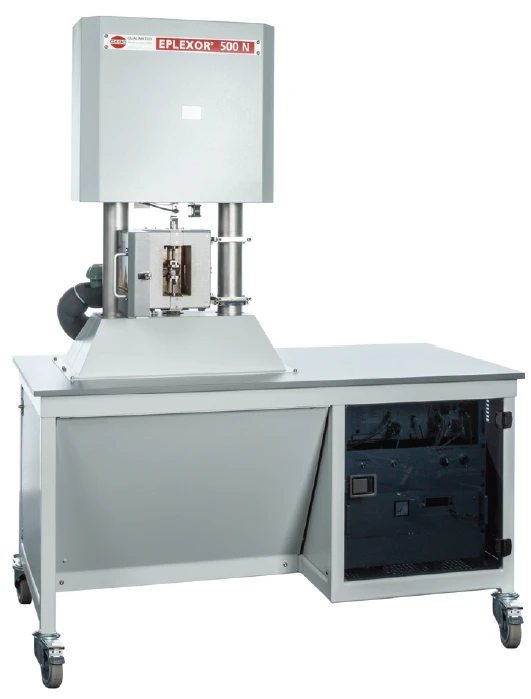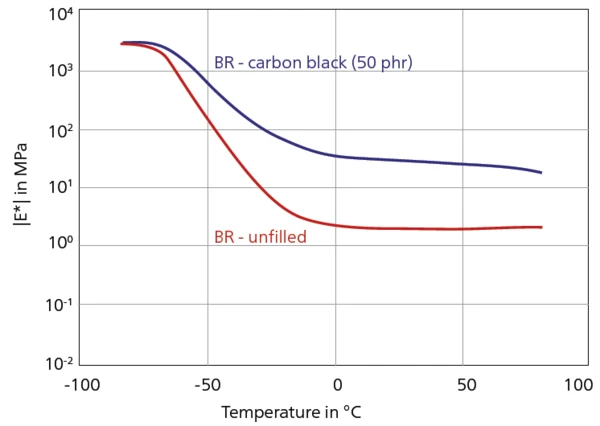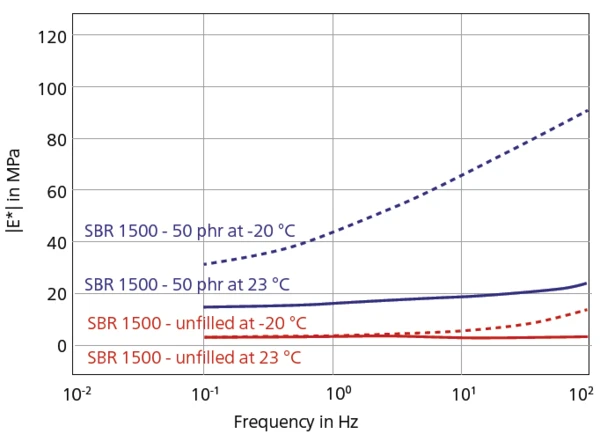Introduction
Today, the method of Dynamic-Mechanical Thermal Analysis (DMTA) is well established in materials research for rubber and tires. The development about new compounds, e.g., in the tire industry, requires detailed information about the mechanical properties of the materials applied. This includes the determination of visco-elastic material data containing the storage modulus E’, Viscous modulusThe complex modulus (viscous component), loss modulus, or G’’, is the “imaginary” part of the samples the overall complex modulus. This viscous component indicates the liquid like, or out of phase, response of the sample being measurement. loss modulus E” and loss-factor tanδ, as function of the temperature, excitation frequency and external deformation (e.g., StrainStrain describes a deformation of a material, which is loaded mechanically by an external force or stress. Rubber compounds show creep properties, if a static load is applied.strain).
Quite popular is the shore-hardness test. Unfortunately, information about the visco-elastic properties obtained by shore tests is lacking in certain significant areas. Data about temperature and frequency dependency of the compounds is not available at all. Furthermore, the deformation applied to the samples during the shore test is not measured.
Only DMTA investigations are able to yield the desired results. Since the visco-elastic properties (E’, E”, tanδ) of elastomer systems depend on the externally applied deformation, temperature sweeps must be performed at constant StrainStrain describes a deformation of a material, which is loaded mechanically by an external force or stress. Rubber compounds show creep properties, if a static load is applied.strain amplitudes over the entire application temperature range.
Due to the high stiffness of rubber compounds at temperatures below the Temperatura de Transición VítreaThe glass transition is one of the most important properties of amorphous and semi-crystalline materials, e.g., inorganic glasses, amorphous metals, polymers, pharmaceuticals and food ingredients, etc., and describes the temperature region where the mechanical properties of the materials change from hard and brittle to more soft, deformable or rubbery.glass transition Tg, high force levels are needed in order to obtain the required static and dynamic deformations.
Normally, for compression tests, cylindrical samples (“Roelig” samples) with a height and diameter of 10 mm are used.
Assuming an E’ modulus of 3,000 MPa, a typical value in the glassy state, the test capacity of the instrument requires a dynamic force amplitude of +/-50 N to generate a detectable elongation of about 2 μm. This cannot be achieved with classical laboratory DMA instruments. Especially wellsuited for these tasks is the Eplexor® 500 N by NETZSCH GABO Instruments (see figure 1).
DMTA systems such as the Eplexor® series by NETZSCH GABO Instruments are equipped with high-power drives to realize suitable amplitudes of high force levels.
In quality control (QC), however, time-consuming temperature sweeps are inconvenient due to economical reasons. QC tests should be carried out very quickly. A QC test, including sample preparation, should be finished in at most 20 minutes. This application note illustrates how temperature sweeps can be substituted by frequency sweeps, carried out close to the Tg.

Temperature Dependence of Butyl Rubber (BR) and SBR 1500
All temperature sweeps are performed at a static deformation of 4% StrainStrain describes a deformation of a material, which is loaded mechanically by an external force or stress. Rubber compounds show creep properties, if a static load is applied.strain as relates to the initial sample length (10 mm for all samples) within a temperature range of -80°C to 80°C. The applied dynamic StrainStrain describes a deformation of a material, which is loaded mechanically by an external force or stress. Rubber compounds show creep properties, if a static load is applied.strain amplitude is ± 0.2%; the test frequency is 10 Hz.
Figure 2 shows the complex modulus of a filled (50 phr carbon black) and an unfilled BR as a function of temperature.
Due to the carbon black content, the modulus of the filled BR is about 10 times higher than that of the pure BR at temperatures above 0°C.
The filled and the unfilled BR systems (figure 3) exhibit a very broad Temperatura de Transición VítreaThe glass transition is one of the most important properties of amorphous and semi-crystalline materials, e.g., inorganic glasses, amorphous metals, polymers, pharmaceuticals and food ingredients, etc., and describes the temperature region where the mechanical properties of the materials change from hard and brittle to more soft, deformable or rubbery.glass transition area covering a temperature range of about 50 K (half-width of the tanδ peak). However, the tanδ peak heights of the two systems are significantly different from one another (filled: tanδ peak maximum is 0.75, unfilled: tanδ peak maximum is 1.3).


Figures 4 and 5 show the complex modulus and tanδ of the second system investigated. Again, a filled and unfilled system were characterized, but this time based on SBR 1500. The pure SBR exhibits a much narrower glass transition peak than the BR system. The half-width of this glass transition was only 20 K. Like before, the absolute values of the complex modulus [E*] of the unfilled SBR drops down from nearly 3,000 MPa below the Tg to values less than 5 MPa above the Tg. The [E*] of the filled systems is – at temperatures above the Tg – double that of the unfilled SBR 1500.


Insert Text
Frequency Sweeps Performed on Filled and Unfilled Rubber Systems
Figure 6 portrays the frequency dependence of the two butyl rubber systems. The complex modulus (E*, displayed as absolute values) of the filled system (BR - 50 phr at 23°C) is simply shifted to a higher level than that of the unfilled BR (BR - unfilled at 23°C). At ambient temperature, the line shapes of the filled (BR - 50 phr at 23°C) and unfilled (BR - unfilled at 23°C) BR compounds are very similar, indicating the same frequency behavior for the filled and unfilled rubbers.

Within the glass transition region at a temperature of T = -20°C, the situation is quite different. The unfilled BR exhibits a much higher slope of the [E*] curve with increasing frequency than the filled system.
Similar results can be obtained for the filled and unfilled SBR 1500 systems (figure 7). As expected, the filled system (SBR 1500 - 50 phr at 23°C) generally shows higher values for the complex modulus [E*] than the unfilled one (SBR 1500 - unfilled at 23°C). The slope of the two curves at room temperature does not differ much. Again, at -20°C, large differences in the line shape can be detected, which allow one to distinguish between different filler contents by analyzing the absolute values of E* as discussed previously.

Summary
Large rubber samples (of 10 mm diameter) can only be investigated in compression mode by using high-force DMA instruments such as the Eplexor® 500 N by NETZSCH GABO Instruments.
The question of in what way E* is a function of the carbon black content can be answered with frequency sweeps performed in thermal equilibrium at different temperatures. Due to the principle of time-temperature or frequencytemperature superposition, variation of the frequency while maintaining a constant temperature can supply the same information as a temperature sweep.
Typically, a frequency sweep only requires about 5 minutes, thus accelerating the test procedure drastically over conventional temperature sweeps, which run about 2 hours.
The test results also show that frequency sweeps carried out close to the Tg allow rubber materials of differing carbon black content to be distinguished by rather quick analysis.